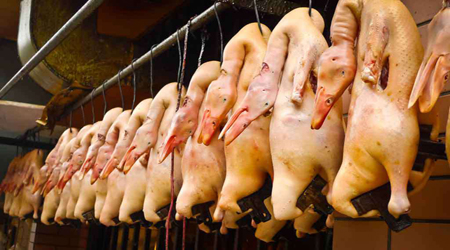Below is a good article I came across on the China web that highlights some “Sherlock Holmes” detective tips for knowing what to buy and NOT to buy whilst shopping in Chinese fresh markets and superstores. Remember, if someone can actually use their creative intentions and time to produce a fake egg to sell, many other items of food can easily be tampered with for good old economic gain. Stay aware and enjoy becoming a good detective 🙂
Editor’s note: this article was translated and edited from Wenxuecity.com and looks at the recent publication of 15 new food safety scares in China by health advice website 39.net. Food safety in China is an ongoing issue that has many deeply worried, and this article details various toxic chemicals and substances that are placed into different foods for varying effects. The article points out some danger signs that you should look out for in order to avoid these tainted foodstuffs, and also details some points regarding what the foods should look or taste like without the addition of chemicals.
Many Chinese people view food as the primary necessity in life, and currently food safety in China is one of the hot topics being discussed. It seems however that unsafe food is everywhere in China and it is something that is impossible to ignore. Recently, Chinese health advice website 39.net (39 健康网) released new information regarding 15 types of food and drink that featured all sorts of unnatural additional materials that made the products potentially toxic. Here, we take a look at the list provided by 39.net and look at the warning signs in determining whether or not the foods have been tampered with.
.jpg)
Photo: The Epoch Times
1) Tea leaves: lead chromate dye used to make the leaves look greener
Lead chromate is a type of industrial dye, and is highly toxic. It is often used in the production of Biluochun (碧螺春), a special green tea from nearby Lake Tai in Jiangsu Province. The tea leaves are brightly colored and have a soft texture, though with the addition of lead chromate the tea can appear darker, greener, and can even take on a bluish shade. After being brewed, normal Biluochun leaves will appear to have a bright pigmentation, and prior to this the leaves are known for their tiny white hairs. If injected with lead chromate, these hairs will often appear green rather than white.
2) Kelp: chemicals added to make it appear greener
If you see kelp that is noticeably wide and especially bright and green, then it’s probably had some chemicals added to it. Kelp is usually a greenish-brown color, and once it is boiled and then left out to dry, takes on a gray-green color.
3) Mushrooms: bleach used to make them a shiny white color
If you see any mushrooms that are unusually white, cheap, and don’t have any remnants of soil left on them, then it’s likely they’ve been soaked in bleaching powder. Good mushrooms are of course grown in the ground, and will inevitably have bits of soil left on them when they hit the shelves. Mushrooms are also naturally pretty sticky, so ones that are smooth and glossy have likely been soaked in bleach.
4) Food soaked in water: softened with formaldehyde
Formaldehyde or hydrogen peroxide is used in food that is soaked in water and can usually be found in tendons, sea cucumbers, squid and bamboo shoots among others. If the product appears especially white and bulkier than usual then it should be avoided. Also, formaldehyde-infested food will have a rather pungent odor, and easily breaks once grasped by hand.
5) Shrimps: ammonia used to give them a sticky texture
Some stores use ammonia to make shrimps appear fresh and sticky. Be sure to choose shrimps that have a dry texture, and avoid any that might have a noticeable odor.
6) Watermelons: hormones used to speed up ripening process
If the yellowy-green stripes on a watermelon appear uneven or if the shape of the fruit itself is irregular or unsymmetrical, then it’s probably seen the use of hormones; which are used to speed up the ripening process. Also, if the pulp of the melon seems unnaturally bright and the seeds are white, then also be sure to avoid. Watermelons with added hormones also aren’t as sweet as normal ones, so watch out.
7) Wolfberries: smoked with sulfur for extra color
Are those wolfberries strangely redder than normal? Do they have a sticky texture and a sour taste? Then it’s possible they’ve been smoked with sulfur. Naturally, wolfberries are a brown, soil-like color, are dry, and taste sweet.
8) Bean sprouts: soaked in fertilizer
Naturally-grown bean sprouts appear straight, thin, have sturdy roots and feature a healthy white complexion. If they appear ashen-colored, coarse, and have little or no roots, then it’s probably the work of fertilizer. One other warning sign is a flow of odorous water that emits from the sprouts once they are cracked open.
9) Rice: industrial white wax and mineral oil used as polishing agents
Bright-looking rice should be approached with caution, as it’s likely they’ve been polished with the either industrial white wax or various mineral oils. Further tests can be carried out such as soaking the rice in hot water and then giving it a feel with your fingers. If the texture is greasy or there are obvious oil stains floating in the water, then avoid. Other signs include a pale yellowish coloring of the rice grains.
10) White fungus: smoked in sulfur for extra color
A “whiter” shade present on white fungus doesn’t necessarily mean it’s going to taste better. When white fungus is smoked in sulfur, its yellowy shade is extinguished, and it also appears somewhat fuller and bulkier than usual. Also, sulfur-smoked white fungus can also be stored for longer than usual (around 10-20 days), though when they begin to oxidize they will turn a reddish hue as opposed to their natural shade of yellow. When buying white fungus, be sure to sample some and watch out for a spicy taste – as that’s another warning sign.
11) Auricularia auricula-judae (Jew’s ear): alum used to maintain crispness
Auricularia auricula-judae, which is more commonly known as Jew’s ear, is a species of edible fungus that, unsurprisingly, takes the shape of an ear. If they have been injected with alum however they often carry an unnaturally sharp, bitter taste – so make sure your taste buds are at their most vigilant.
12) Tripe: soaked in hydrogen peroxide or formaldehyde for whitening
Tripe that looks notably white has probably been soaked in either hydrogen peroxide or formaldehyde for a few days. Also, if the body of the tripe appears bigger than normal or seems brittle and even withers up after being heated, be sure to avoid.
13) Dried chili peppers: smoked in sulfur for extra color
As mentioned earlier, food that is smoked in sulfur will often appear much more brightly colored than normal, and the same goes for dried chili peppers. Normally, chili peppers have somewhat of a dark reddish hue, so watch out for overly bright ones. Also, if you rub the peppers with your hands and notice them being stained yellow, that’s also likely to be a sign of sulfur.
14) Tofu strips: rongalite used as a bleaching agent
Rongalite, which is also known as sodium formaldehyde sulfoxylate (among many other names), is used as an industrial whitening agent that today is sometimes used in cosmetic hair dye removers. In tofu, the chemical makes the substance appear whiter and also gives it a tougher texture. Healthy tofu strips should have a pale yellow shade, and thin fibers can be seen if they are placed in the view of light. Other safe signs are its general brittleness and the emergence of yellow-colored water when they’re being soaked.
15) Daylily dishes: smoked with sulfur for increased storage time
In order to extend its storage time, daylily dishes are smoked with sulfur which makes old stock appear more fresh and dry. Daylily dishes that have too much sulfur dioxide appear pale yellow and white, and also have a pungent acidic odor. Prior to eating daylilies, it’s a good idea to soak them in clean water several times for around 30 minutes just to be safe.
Source: Wenxuecity









Leave A Response